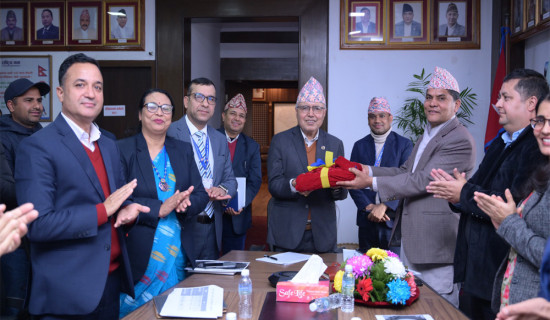- Tuesday, 30 December 2025
Efforts underway for conservation of Dar tree
By Anil Parajuli,Hetauda, July 31: The traditional containers made of Dar tree used by our ancestors to store milk and curd are becoming difficult to find these days.
To conserve this traditional container to keep milk and curd, the Division Forest Office Makawanpur has started to produce saplings of the wood to produce such items in Chapaki of Bakaiya Rural Municipality-12.
From there, seeds of Dar, also known as gitthi or paro, are collected, grown in nurseries, and then planted in various areas of the district.
At times, Dar-made containers would be a signature of Makwanpur but they are rare these days. So the initiatives have been launched, including the establishment of a seed garden, seed collection, nursery, plantation, and a conservation committee in the district.
According to Forest Officer Basanta Raj Gautam, the area has been designated as a dar pocket area for reforestation and conservation.
Assistant Forest Officer Deepak Adhikari of the Division Forest Office in Makawanpur shared that about 100 saplings were planted over 2.3 hectares of fenced land over the past two fiscal years. Dar trees can be found in Bakaiya, Manahari, Bhaisey, Bhimphedi, Makawanpur Gadhi, Thingan, and the northern regions of Bagmati.
The previously planted dar saplings have been growing well, with additional plantation completed in the second week of July this year. “Dar wood is highly valued. Unlike other wooden containers, dar wood containers prevent milk and curd from being spoilt and developing a foul smell. Containers made from dar wood are versatile and significant,” Gautam explained.
Dar wood is lighter than other types of wood, making it ideal for to make various utensils such as cups, plates, harpe (wooden containers to keep ghee), dudheri (milk jugs), and theki (curd containers). Food stored in these wooden containers has a better flavour, and curd sets well in dar wood containers.
According to the Division Forest Office's approved annual programme for fiscal year 2023/2024, the development of dar as a pocket area is being pursued with local community participation.
Under the approved annual programme in the fiscal year 2022/2023, valuable dar species were conserved in Kolkhop Forest Area, Bakaiya-12, by creating a seed garden and producing seedlings in a nursery for plantation.
Similarly, another 200 dar trees were numbered for seed garden creation, and seeds collected from the garden were used to produce seedlings in the Division Forest Office and Rapti nursery for promoting dar plantation, Gautam said.
Dar also has medicinal value. Its bark is used to stop bleeding from cuts and to heal wounds quickly. The sap from the bark is used to leaven traditional bread like sel roti and finger millet roti.
Local communities use it to treat skin blisters. Traditionally, dar leaves were crushed into a paste and applied to wounds and broken limbs and used as a traditional medicine for diabetes, though modern medicine is gradually replacing these practices.
Dar grows well on weak, sloping land and dry areas, making it useful for restoring degraded land and controlling soil erosion.
Farmers use dar leaves as fodder, but its slow growth and low interest among farmers have hindered new plantation and tree production. Recently, community forests have focused mainly on Sal trees, with dar receiving less priority from government levels, leading to its decline.
For sustainable management and conservation of dar species, extensive research, protection of natural habitats, control of forest fires and encroachment, development of private and agroforestry systems, planting by farmers in community forests and private lands, and provision of subsidies through municipal or forest offices or wood-based industries could play significant roles, experts said.
According to Forest Regulations 2023, dar can be collected, utilised, and sold like other species, with a royalty of Rs. 15 per kg of dar bark.
According to the Forest Department (2020/21), dar forests are found at altitudes of 300 to 1,700 metres in Udayapur, Dhankuta, Panchthar, Ilam, Makwanpur, Chitwan, Nuwakot's Trishuli area, Gorkha, Tanahun, the Kali Gandaki banks in Parbat, Palpa, Gulmi, the Chure area in Dang, Salyan, Jajarkot, Surkhet, Doti, and Dadeldhura.





-square-thumb.jpg)










